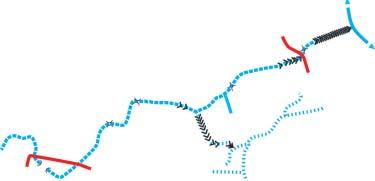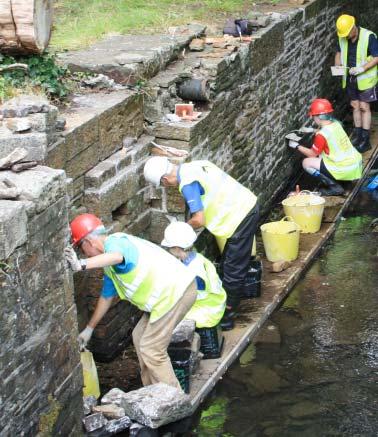
17 minute read
provisional) news on six summer sites
coming soon-ish...
As we go to press it’s looking like we might actually run some kind of Canal Camps
WRG Summer Canal Camps2021
No, you didn’t mis-read that! We really do think that there is enough of a likelihood of us being able to operate a programme of Waterway Recovery Group Canal Camps in summer 2021 that we’ve started on some detailed planning - and we want Navvies readers to know about it as early as possible, so that you can make plans for some summer volunteering.
There’s still a lot of organisation and planning work to do, and a limited time to do it in (in a normal year we would usually have worked out at least a provisional schedule at the Bonfire Bash the previous November - but clearly in November 2020 there was no point in us planning anything), and everything might change with the next twist in the Covid-19 saga. So this preview article comes with more than the usual disclaimers...
Nothing in this article is definite at all: it might only take (say) another new and nastier strain of Covid to change the national situation enough to knock the whole lot on the head. Or we might be unable to find accommodation that satisfies our updated requirements in the new era. Or any number of other possible glitches which might impact individual sites, reduce the amount of suitable work for us, or push our dates back further into the future. And speaking of dates, we aren’t in a position to give you any yet, other than the general idea (see panel opposite) that we’ll hope to kick off the programme around August. These are a selection of six projects on six waterways which are the front-runners as Canal Camps projects this summer, if and when that pro- Martin Ludgate gramme happens. Canal Camp site for 2021? The Swansea Canal on a 2017 Canal Camp page 8
Canal Camps pre-preview...?
programme this summer after all. So here’s where WRG might be working in 2021
So why are we bothering to tell you about it at all if it’s all so undecided and vague? Well, partly because we want you to know that our people are doing their best to put together a camps programme, so that if and when we can give you something more definite (in the next Navvies and/or via the WRG website and Facebook group) you’ll be more likely to be in a position to book on.
But also because all of these projects, whether or not they ultimately end up as work sites for WRG Canal Camps during summer 2021, will undoubtedly be completed in the foreseeable future, largely by volunteers, and almost certainly with WRG input. So it’s worth us telling you about them, whether you end up being able to work there on a summer camp this year, or perhaps next year, or on a weekend dig with a WRG regional group or other mobile group, or by joining a local canal society working party.
However having said that, I really do hope to be able to see some of you on a Canal Camp on one of these sites this summer.
Now turn the page and read about six potential Canal Camps projects...
Canal Camps 2021
Following much discussion involving the WRG Board and Covid-19 Working Group, WRG is cautiously optimistic that we will be able to return to getting out and about on Canal Camps from the start of August onwards (by which time it is anticipated that the majority of the population will have had their first vaccination).
The team at head office are now putting the plans together behind the scenes to work towards this date and will be working with canal restoration groups across the country. In exceptional circumstances the WRG Board may approve individual camps to proceed prior to the 1st August 2021, where a rigorous assessment of risks from Covid on site and at the accommodation will be undertaken.
Full guidance on additional controls (compared to pre-Covid camps) will be put together by WRG covering the following issues:
·Attendee numbers · Accommodation requirements · Local and regional restrictions · Safe travel and transport · On-site controls Each camp will be reviewed and will undergo a rigorous assessment to determine that the organisation is comfortable that the risks can be minimised.
Mobile groups’ weekend working parties: WRG’s regional groups are considering a slightly earlier return to weekend digging, but are currently reviewing their risk assessments and options. Regional digs may differ from the normal way they are run, with the organising groups opting to run single day events or relying on volunteers to arrange their own accommodation and catering options.
Other restoration opportunities: In the meantime, while you are itching to get out and digging, there are plenty of canal restoration groups still working on their vital projects who would welcome your support.
Disclaimer: We must note however that while we are planning to run camps, external factors such as new Covid variants, government restrictions and guidelines, may lead us to having to cancel single camps or even the whole circuit.
preview Derby and Swansea
Looking forward to finishing the Derby Canal’s part-restored Borrowash Lower Lock, and returning to South Wales for another Swansea camp
Derby & Sandiacre Canal
The Canal Camp work: Working on the completion of the rebuilding of Borrowash Lower Lock, on the Derby to Sandiacre length.
Why is it important? Volunteers began work here some years ago, but then other projects elsewhere on the route took priority, so the lock was left part-restored. In recent years the Trust has returned to Borrowash to finish the job - supported by a WRG Canal Camp in 2019. In the medium term the Trust hopes to establish a temporary water supply to enable this section to be re-watered - and looking further ahead, there is the prospect of linking up with other projects including the 1km restored section at Draycott and the adjacent canalside cottages under restoration to provide a canal centre and cafe, plus a rental income to pay for further restoration.
The wider picture: In the longer term this length forms part of the Trust’s plan reopen the lengths from Sandiacre and Swarkestone to the outskirts of Derby, connect them together by a new route bypassing Derby, and link it to the city by a boat lift and a length of the Derwent.
Jess Leighton
Working at Borrowash on the 2019 camp

Derby & Sandiacre Canal
Length: 14 miles Locks: 9 (on main line Swarkestone-Sandiacre) Date closed: 1964
DERBY Original route obliterated Proposed diversion past Derby Erewash Canal to Langley Mill
Sandiacre
Proposed new route into Derby using River Derwent
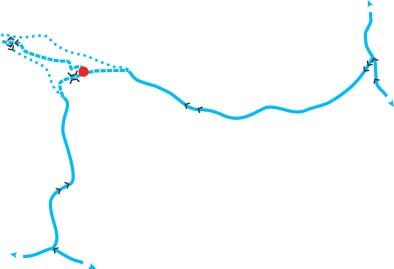
Swarkestone Trent & Mersey Canal to Burton page 10
Proposed new aqueduct and boat lift
Trent & Mersey Canal to Shardlow Borrowash Locks work site
Erewash Canal to the Trent The Derby & Sandiacre Canal (or to use its original name the Derby Canal) was opened in 1796 for 14 miles and 9 locks from Sandiacre on the Erewash Canal via Derby (where it crossed the River Derwent on the level) to the Trent & Mersey Canal at Swarkestone, plus a branch (not shown on the map) leading north from Derby to Little Eaton. Initially successful, by the 1840s the canal was suffering from competition from railways, although it wasn’t until the 1940s that trade ended. It was allowed to fall derelict and despite protests by the Inland Waterways Association it was abandoned in 1964. It was drained, some lengths near the centre of Derby have since been obliterated, but much of the rest survives.
The Canal Camp project: We’re likely to be working near the southern end of the surviving length of canal in the Clydach area.
Why is it important? Following restoration work at Pontardawe Locks in recent years, a funding grant has enabled the section below these locks to be dredged. Later this year Glandwr Cymru (the Canal & River Trust in Wales) is scheduled to carry out further dredging south to Clydach, while work on vegetation clearance is also planned, with the aim of bringing this section up to navigable standard and starting a tripboat operation.
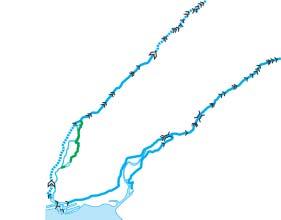
The wider picture: With the top five miles from Godre’r-Graig to Abercraf largely lost to 1970s road improvements, and the bottom five miles from Swansea Docks to Clydach mostly buried under urban development, Swansea Canal Society is concentrating on the middle six miles from Clydach to Godre’r-Graig - including Ynysmeudwy and Trebanos locks plus the buried lock at Pontardawe. But in the longer term there are plans for a diversionary route to be created, bypassing the missing lower length southwest of Clydach. This would
Darren Shepherd Re-pointing stonework at Ynysmeudwy Lock on the 2019 camp
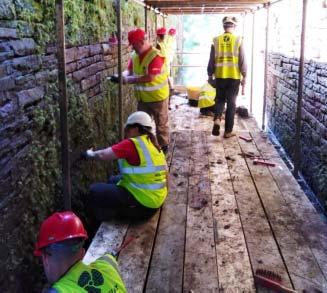
combine sections of new canal, the Nant Fendrod stream, the Fendrod Lake and the River Tawe, and end up in Swansea’s eastern docks. There it would link to the Tennant Canal, which would also be restored, creating a route which has been dubbed the Swansea Bay Inland Waterway, connecting to the Neath Canal. Completing the restoration of the Neath Canal (two long sections have already been restored) would ultimately create a 35-mile connected local canal network. Length: 16 miles originallySwansea Canal Locks: 36 originally Date closed: 1928-1960 The Swansea Canal, opened in 1798, descended steeply from Abercraf down the Tawe Valley, passing through 36 locks in the 16 miles to Swansea. It was very busy with coal and iron traffic, even Abercraf after it was taken over by the Great Western Railway. However by the late 19th century trade was in decline, the last loads were carried in 1931 and it closed in sections with the final length abandoned in 1962. Much of the upper canal was buried under Swansea Canal Neath Canal Glyn-Neath Pontardawe Godre’r-Graig Upper lengths lost under new road Ynysmeudwy a new main road up Trebanos Old route Resolven the valley, while the Clydach obstructed Abergarwed lower sections were Proposedbuilt on as Swansea diversion Aberdulais expanded,but the six miles from Godre’r- Neath Graig to Clydach survived moderately Swansea Tennant Canal Briton Ferry intact.
preview Cotswold and Lichfield
Rebuilding Westfield Lock, our contribution to the next phase of the Cotswold restoration, and helping link up sections of the Lichfield Canal
Cotswold Canals
The Canal Camp work: Beginning rebuilding the part-demolished Westfield Lock on the Stroudwater Navigation, and reinstating Oldbury aqueduct / culvert under the lock head.
Why is it important? This will be the major volunteer contribution to the £16m package to restore the Phase 1b section of the canal from Saul Junction to Stonehouse - and our work counts as part of the required ‘match funding’ to the £9m from the National Lottery Heritage Fund providing the majority of the funding. And the schedule of works (see Navvies 304) shows it due for completion by the end of 2023, so that the canal can open in 2024.
The wider picture: This will link up with the already completed Phase 1a length, bringing visiting boats onto 10 miles of canal up to Brimscombe Port. And it improves the case for funding the subsequent phases, eventually opening the entire through route.
Martin Ludgate

Wallbridge Lock on the Cotswold, now completed
Cotswold Canals
Length: 36 miles Locks: 56 Date closed: 1927-1946
The Cotswold Canals refers collectively to two canals being restored to recreate the through route from the River Thames to the Gloucester & Sharpness Canal (and so to the River Severn). The Stroudwater Navigation was opened in 1783 from the Severn up the River Frome valley to Stroud; then in 1789 the Thames & Severn Canal continued from Stroud through the Cotswold hills to the Thames at Inglesham. The Thames & Severn suffered from problems of water shortage, leakage, the difficult ground that the summit tunnel at Sapperton passed through, and being leased by a not-too-friendly railway company for much of the late 19th Century. A final attempt by Gloucestershire Council to repair it and encourage trade proved futile: most of the Thames & Severn shut in 1927, the rest in 1933, and the Stroudwater followed (despite IWA opposition) in 1954. Following closure the Thames & Severn passed to many local landowners, making restoration more complicated politically, but the Stroudwater remained in the hands of the original company - although the destruction of a mile of the route neat Whitminster when the M5 motorway was built in the 1970s hasn’t helped matters.Phase 1b: Saul to Stonehouse

Phase 1a: Stonehouse to Brimscombe Phase 3: Brimscombe to Cerney
North Wilts Canal to Swindon Phase 2: Inglesham to Cerney
The Canal Camp work: likely to be either on one of two lengths that Lichfield & Hatherton Canals Restoration Trust’s volunteers are currently working on. One is the length of canal from Fosseway Heath (where we helped to rebuild the collapsed towpath wall on the 2018 camp) to Falkland Road (where a new diversion channel is being built alongside the Lichfield Southern Bypass road). The other is at Gallows Reach, where a length of historic towpath wall is being restored.
Why is it important? The Fosseway Heath section is being reinstated initially as a local nature reserve, but ultimately as part of the restored canal. At Falkland Road the canal takes a diversion (to avoid a section that has been built on) and LHCRT volunteers have been busy working on creating a new length of channel alongside the road. It’s really important that local people can see some good progress on the ground on this highly-visible section of new canal for several reasons in addition to it being a practical step towards reopening the canal.
To reinstate the next section east of Falkland Road will involve shoe-horning the diverted canal through a constricted corridor alongside the next section of the bypass to be built; tunnelling through a railway embankment; and crossing the access roads to new housing developments (whose developers haven’t always been keen to make provision for the canal). Good progress on the canal at Falkland Road, and at Gallows Reach (the next section further east) will bring pressure to bear on the authorities to support eventually linking all these section of canal together.
The wider picture: The next stage will be to connect these lengths to the restored Tamworth Road Locks, as a step towards reopening the canal through to Huddlesford Junction, bringing in boats from the Coventry Canal.
And that would then mean that the restoration project was more than half way to opening the entire line from Huddlesford to Ogley Junction.
Martin Ludgate
London WRG at Gallows Reach in early 2020 Length: 7 miles Locks: 30 Date closed: 1955Lichfield
To FradleyDiversions to be built to avoic CoventryCanal obstructions to restoration A38 Huddlesford Canal LICHFIELD

To Coventry
To Anglesey Basin Ogley M6Toll Junction BypassA461
A5
Fosseway Heath work site
Wyrley & Essington Canal to Wolverhampton A51
Tamworth Road Locks HS2?
Next part of bypass to be built
Gallows Reach work site Heritage Lock 23 ‘pinch point’ New channel being built alongside Falkland Road section of bypass The Lichfield Canal is the name given by canal restorers to the abandoned eastern six miles or so of the Wyrley & Essington Canal. The canal originally stretched from the Birmingham Canal Navigations Main Line in Wolverhampton to a junction with the Coventry Canal at Huddlesford, but this eastern length which included all 30 of the canal’s locks was closed in the 1950s to save the cost of maintaining the locks.

preview Waveney and S&N
And finally, we hope to be heading east to finish Geldeston Lock on the Broads, and west to Shropshire for the Shrewsbury & Newport Canals
River Waveney
The Canal Camp work: Completing the rebuilding of Geldeston Lock, at the head of the navigable tidal reaches of the Waveney.
Why is it important? With the other two locks on the Waveney having been replaced with sluices, that left Geldeston Lock as the last remaining (moderately) intact structure surviving from this littleknown Broadland navigation. In recent years it was becoming increasingly derelict and liable to collapse, so it was important to restore it to stop this happening. And having rebuilt one wall and part of the other during the 2017-19 Canal Camps, it’s important that we finish the job.
The wider picture: Although there are no plans to reopen the upper Waveney to navigation (the treatment of the other two locks since closure would make that difficult), the aim is to preserve this sole survivor as a restored historic structure. The hope is that the rebuilt lock chamber can be used to dispay Albion, the last survivor of the cargo-carrying wherries (the historic sailing barges of the Broads), which was built to work on the Waveney and would have passed through here Dave ‘Evvo’ Evans regularly in the early 20th Century. Working from a boat at the 2018 Geldeston camp
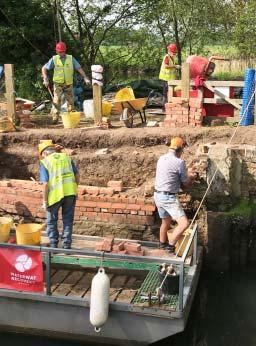
River Waveney
Length: 4 miles Locks: 3 Date closed: 1934
The River Waveney above Beccles was made navigable as long ago as 1670, when the creation of the River Waveney Navigation saw three locks built to allow boats to continue from the tidal reaches (which were already in use between Breydon Water and Beccles), on up to Bungay. These lower lengths (plus their links to Lowestoft and the upper Yare) still form part of the Broads; however the length above Geldeston fell out of use and closed in 1934. Since then the upper two locks have been replaced with water control sluices, while Geldeston Lock survived intact but increasingly derelict.
Unnavigable and locks abandoned above Geldeston

Bungay Wainford Lock Ellingham Lock
Geldeston Lock Work site: Geldeston Lock Tidal river to Breydon Water and Great Yarmouth
Navigable up to Geldeston Beccles
The Canal Camp work: Likely to be working either on the restoration of Berwick Tunnel’s portals and approaches, or at Wappenshall Junction, where the Shrewsbury Canal meets the Newport Canal, and where Shrewsbury & Newport Canals Trust is working to re-water the canal basins at the junction, and to restore the historic canal warehouses.
Why is it important? Berwick Tunnel is a surviving historic structure on a length of canal which SNCT believes could be a showpiece restored section. The original towpath is being reinstated on the approaches to the tunnel, and at the western end a second path will be created on the opposite side, with the aim of creating a circular walk involving both paths. And at Wappenshall, the plan is to establish a canal centre, exhibition and meeting room in the warehouses, with historic boats on show in the basins. Given their proximity to Shrewsbury and Telford towns respectively, both the tunnel end walk and the canal centre have good potential to generate publicity and support for the canal, enabling further restoration work.
The wider picture: In the medium term SNCT aims to open a longer length of canal linking Berwick Tunnel with the popular nearby Attingham Park which could support a trip-boat operation and really raise the restoration’s profile. Elsewhere on the route, the Trust ha also carried out work between Forton and Newport. And ultimately its goal is to link all these projects into a fully restored navigable route from Norbury Junction to Shrewsbury
Bernie Jones Wappenshall warehouse and preparing to line basin
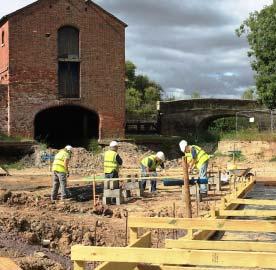
Length: 25 milesShrewsbury & Newport Canals Locks: 25 Date closed: 1944
The Shrewsbury Canal, opened in 1979, was 17 miles long with 11 locks and one inclined plane boat lift. It linked Shrewsbury to Trench where it connected to the existing Shropshire tub-boat canals, and was originally built for trains of small tub-boats about 20ft by 6ft (four at a time in the 81ft long locks, or singly on the inclined plane). In 1835 it was connected to the rest of the Midlands waterways network by the opening of the ‘Newport Canal’ - the Newport Arm Shropshire Union which branched off the Shropshire Union Canal’s main line at Norbury Junction to Ellesmere Port and ran for 10 miles and 23 locks (built to take standard narrow boats around Norbury70ft by 7ft) via Newport to Wappenshall Junction where it met the Shrewsbury Canal. The two locks between Wappenshall and Shrewsbury A41 Junction were widened so that standard narrow boats could work through to Shrewsbury Wappenshall To Autherley (and will be able to use the Eyton Locks work site Newportrestored route). Both canals (widened 1830s) became part of the Berwick Tunnel InclinedShropshire Union work sites Planesystem, and later Trench Locks the LMS Railway, Shrewsbury A5 (never widened) Trench Former Shropshire tub-boat canals (notwhich proposed for restoration)closed them in 1944.
